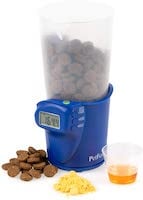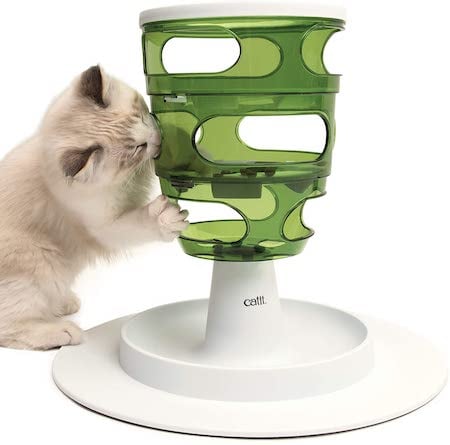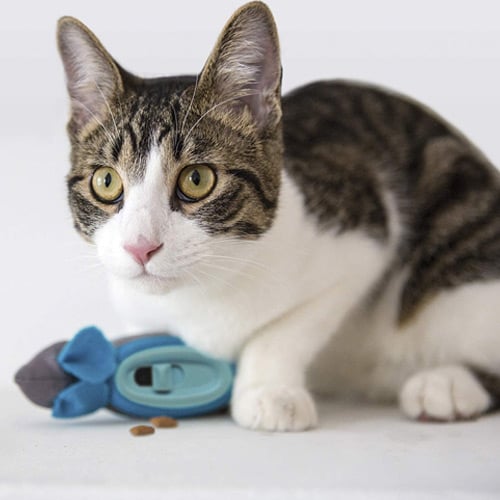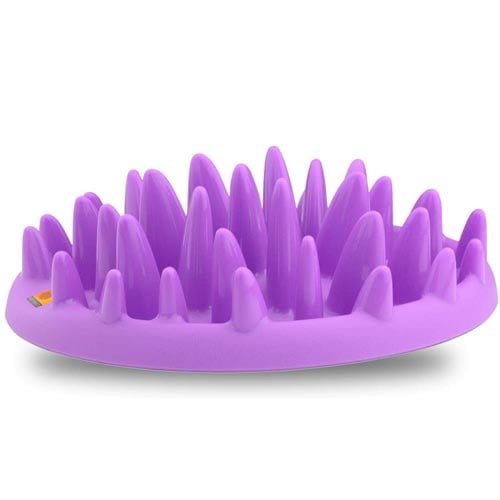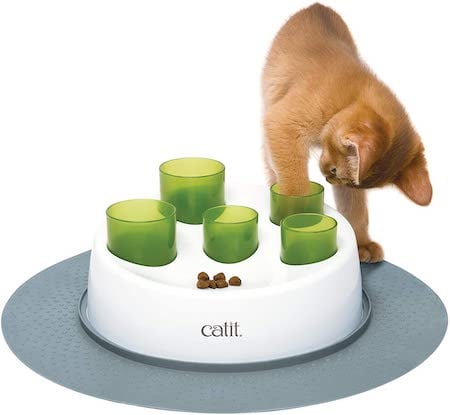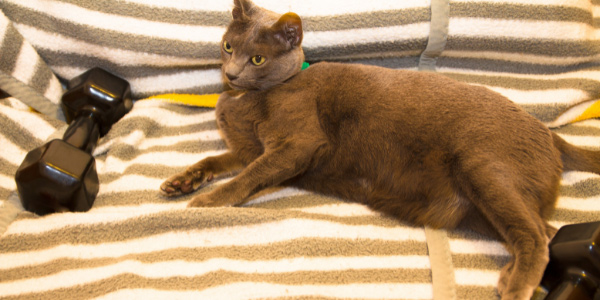 Losing weight is a challenge — for two-legged and four-legged species alike!
Losing weight is a challenge — for two-legged and four-legged species alike!
Cats are hit by this challenge more than other companion animals, with a whopping 59.5% of cats in the U.S. classified as overweight or obese (as compared to 55.8% in dogs).1
This equals an estimated 56 million cats who are overweight or obese.
Why is this a concern?
Because, like people, obesity is associated with serious health conditions in cats. Some of the more common medical issues associated with excess weight are:
- Type 2 diabetes
- Heart disease
- Arthritis
- Joint injuries
- High blood pressure
Some startling facts about obese and overweight cats when compared to their trimmer, normal-weight counterparts are they are three times more likely to develop type 2 diabetes, have a shorter life span, and don’t physically interact as much with their families.
The good news is there are some proven ways to help your cat shed those extra pounds. So, let’s get started!
1. Talk with Your Veterinarian about Your Cat’s Weight
Veterinary supervision is especially important for cats because if they lose too much weight too quickly, they can develop a life-threatening liver disease called hepatic lipidosis (also known as fatty liver disease).
This occurs when the body breaks down too much fat too rapidly, and the liver cannot process it quickly enough. This causes the fat to be stored in and around the liver, leading to decreased liver function and sometimes even liver failure.
If cats do not eat for as little as two consecutive days, they can develop hepatic lipidosis, which can be fatal if not diagnosed and treated quickly and aggressively.
Your veterinarian will help design a gradual weight loss program for your kitty so rapid weight loss triggers, which can lead to hepatic lipidosis, are avoided. A prescription diet may be recommended to help your pet feel fuller on less food.
Remember, never suddenly change your cat’s diet. Rather, do it gradually over 1–2 weeks, sometimes 3 weeks (read more about how to switch your cat's food here).
Each year (or every 6 months for senior pets), at your pet's wellness visit, ask your veterinarian to evaluate your cat's weight and body condition. Ask them if your cat is just right, too high, or even too low.
Here's a chart developed by Nestlé Purina that many veterinarians use when evaluating a cat's body condition:
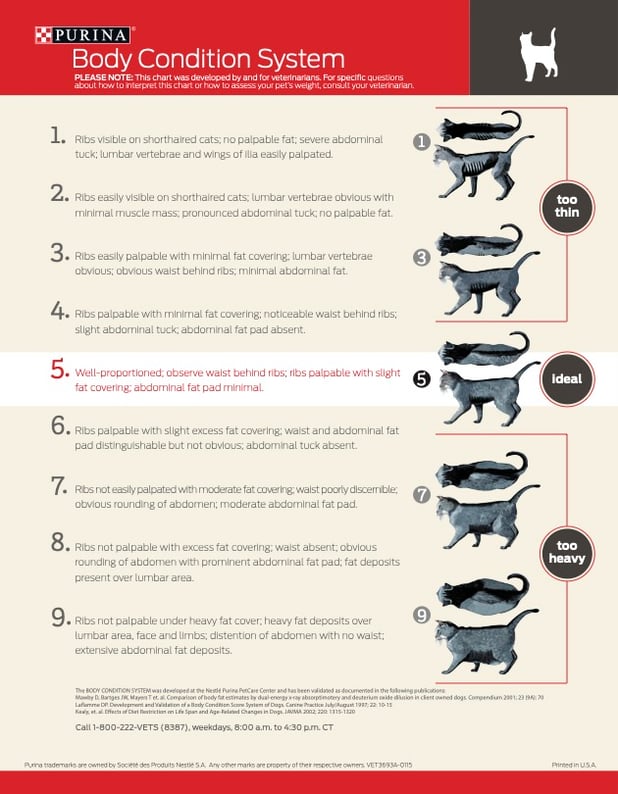
Once you know where your pet falls on the body condition scale, you and your veterinarian can come up with a plan to either keep your pet at their ideal body condition and weight or to help get them there. Knowing what to aim for is very helpful.
PRO TIP: Before going to your cat's wellness visits, write down the brand and formulation of the foods you're feeding your cat, as well as the amount you feed. That way, when your vet asks, you're prepared and can get the most out of your pet's visit.
You can also take a picture of the front and back of your cat's bag of kibble or can of food to know the formulation and ingredients (as shown in the photos below), and do the same for any treats you regularly give your kitty.
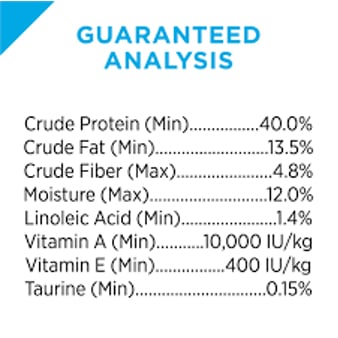
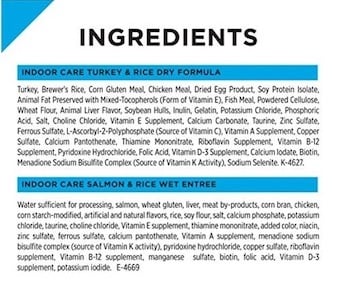
2. Pay Attention to How Much You're Feeding Your Cat
You can achieve this by getting a set of dry measuring cups specifically for your pet’s food. They’re inexpensive and easy to find. Or you can make feeding even more precise, without spending much more money, by getting a small kitchen scale to weigh the amount of food you’re feeding your cat.
Use Your Pet Food Scoop Correctly
There are fine lines on the inside of most pet food scoops that indicate where the cup measurements are (e.g., 1/4 cup, 1/2 cup, etc.). If your scoop doesn't have these lines, stop using it and start using proper measuring cups!
Avoid adding “just a bit” more food above the measurement lines. Those little bits add up over time, especially for smaller pets under 25 lbs., like cats.
And if you're feeding your cat by weight rather than volume, invest in a portable and easy-to-clean digital pet food scale.
Not sure how much food your cat should be eating every day? Read more in this article about "How Much and How Often You Should Feed Your Cat."
3. Consider What You’re Feeding Your Cat
What you feed your cat is just as important as how much!
Watch out for commercial “diet” kibble. They’re often puffed up with air. You may feel like you’re feeding your cat plenty, but they’ll still be hungry because that air isn’t providing any real fullness.
And a cat who’s hungry all the time can become aggressive and less tolerant with other pets and people. Who can blame them? I'd be "hangry" too!
Look for a food with more protein and fiber — aim for less fat, carbohydrates, and calories. And make sure there’s a quality protein source in the first three ingredients of the ingredient list.
Try adding or increasing the amount of wet food your cat eats. The density and higher water content are very filling. And the calories and carbohydrates are much less than you generally find in dry kibble.
So, your cat gets to eat considerably more volume of food while staying within their daily calorie goal. 60% wet food and 40% dry food is a great ratio for overall health.
Try adding a little canned pumpkin to your cat’s food. It’s high in fiber and moisture, both of which will keep your cat feeling full longer. Start with just 1/8th teaspoon and work up to around a teaspoon a day. Make sure it's pure pumpkin and not pie filling.
You can portion out servings in an ice cube tray and freeze them, so nothing goes to waste in the fridge.
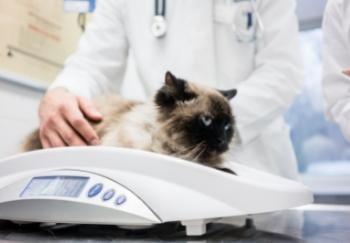
4. Weigh Your Cat Regularly
Your pet’s weight can be a good indicator of health when it is tracked.
Regularly tracking a pet’s weight, rather than just at yearly check-ups, helps pet owners notice the slight changes in weight, which might be hard to see.
This is especially important for cats because of their small size, making gradual weight loss or gain more difficult to recognize.
Consider a typical 10-pound cat: Weight loss of only 6% — less than 10 ounces — could be an indicator of a medical problem if it takes place during a short period of time.
Ideally, it would be best to weigh your cat weekly or at a minimum, monthly.
It is easy to not notice a few pounds of weight gain, but after a while, those few pounds start adding up.
It’s easier to be proactive about weight gain if you know your pet’s ideal weight for their age, breed, and size and can frequently check what they weigh.
How to Weigh Your Cat
Many cats (as well as dogs and humans) don’t love getting on a scale. Here are a couple of tips to get your cat’s weight at home:
- Start by weighing yourself on your scale. Make a note of your weight. Gently pick up your cat, making sure that they are supported in your arms. Stand on the scale while holding them and weigh yourself and the cat combined.
Make a note of this combined weight. Subtract your weight from the combined weight to calculate the weight of your cat. - If your cat doesn’t like being held, you can use a cat carrier instead. Start by weighing the cat carrier while it is empty. Make a note of the carrier’s weight. Place your cat inside the carrier and ensure the door is securely closed. Weigh the carrier with your cat inside.
Make a note of this combined weight. Subtract the weight of the empty carrier from the combined weight to calculate the weight of your cat. - Another option is to place a towel or non-skid mat on the scale, make sure it’s reset to “0,” and then have your pet step on. Often simply changing the surface of the scale helps pets feel like they have better footing, encouraging staying on it longer.
- For more accuracy, purchase an inexpensive digital scale designed for infants and small pets. These scales measure pounds and ounces more precisely, making them the best to use because they are more accurate.
5. Monitor Your Cat’s Treat Intake
Just like dogs, treats can be a source of joy for cats too! And there are a lot of out there to choose from, making the best choice for your cat’s health difficult. For some excellent guidance, refer to our article "Choosing the Best Cat Treats."
Unlike commercially prepared cat foods, most cat treats are not complete and balanced. This is because in order to make a crunchy cat treat, the level of carbohydrates is usually too high for cats.
For this reason, treats should not provide more than 10% of a cat's energy/calorie intake. Not only do too many treats contribute to cats becoming overweight and obese, but they can also upset your cat’s nutritional balance, as well as impact their appetite for their regular food.
The exception to the 10% treat rule is when a high-value food treat is needed to motivate your cat for training and positive reinforcement purposes (cats aren’t usually willing to put in the extra effort for their everyday kibble).
Just make sure you’re choosing healthy treats that are cooked without any added salt, preservatives, or artificial coloring. And remember to remove those extra calories from their daily meals.
6. Increase Physical Exercise for Your Cat
Increase your cat’s level of daily exercise. For cats, this usually is in the form of interactive play with their person.
Not only does this burn the calories, but it also enriches your cat's life by helping them express their hunting instincts, providing mental and physical stimulation, and it increases the bond between the two of you!
The sessions do not need to be very long, but they should be predictable (for example, daily at about the same time).
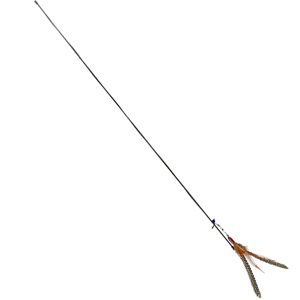 A popular choice is the Da Bird wand toy. It simulates the motion of a bird. Set on a swivel, its feathers look, sound, and feel like real bird wings and will drive your cat nuts.
A popular choice is the Da Bird wand toy. It simulates the motion of a bird. Set on a swivel, its feathers look, sound, and feel like real bird wings and will drive your cat nuts.
This toy encourages instinctual behaviors and exercise to keep your cat healthy and alert.
Pro Tip: Play bird sounds on your phone (or TV) while using this toy, or other similar ones. It's great for cats to engage their sense of hearing while playing with toys that simulate birds.
Click here for a great YouTube video of birds and squirrels.
If your cat likes to chase things, you can take a portion of their daily kibble and play a little game.
Toss a piece across the room or slide it across the floor so your cat can run after it, pounce, and then gobble up the reward. This is a great way to get them moving.
Another popular toy is the use of a laser pointer. Be aware that the use of laser pointers may lead to frustration because the cat never gets to catch the prey (that is, the light from the laser).
Either avoid the use of laser pointers or always finish the game by having your cat “catch” some treats or a physical toy. They need to finish the hunt-and-catch sequence.
More and more people are teaching their cats to walk on a harness and leash. This is another great source of exercise, as long as it is done safely. To learn how to do this safely, check out "Taking Your Cat for a Walk."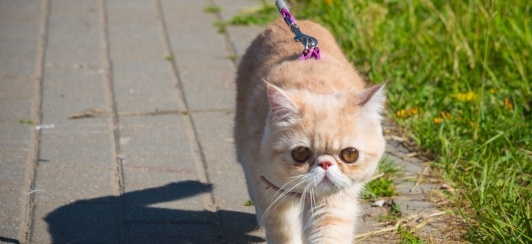
Please remember, just like we can’t go out and run a marathon without conditioning our bodies, neither can our pets. Plus, a lack of physical conditioning can create an increased risk for injury and arthritis.
Taking it slow is especially important for obese or senior pets and those with health issues. Consult with your veterinarian as to the best way to start and continue an exercise routine. Slow and steady wins the race!
7. Use Slow-Feeders, Interactive Food Puzzles, or Hide and Seek
Slow down the rate of your pet's eating to help them stop when they are full, rather than gobbling up their meal regardless of their hunger status.
This can be done by skipping the regular bowl and feeding them with a puzzle or interactive toy.
Another way you can slow down their eating is to add some water to their food. Learn more in the article, The Best Cat Food Bowls and Interactive Feeders to Delight Your Kitty.
You can also try taking a portion of their daily kibble and hiding it throughout your home. Under the couch, on the dining room chair, behind a pillow — these give your cat a chance to use their noses and do some hunting.
That means they’re up out of the comfy chair and on the move.
Dry Food Feeders That Cats Can Push, Chase, and Hunt Their Food
Feeders That Also Work with Wet Cat Food
8. Monitor for Medical Problems that Contribute to Cat Weight Gain
Talk to your veterinarian to see if there might be a medical problem that could be contributing to your cat’s excessive weight (such as a low-functioning thyroid, overactive adrenal gland, a buildup of fluid, or one of any other number of possible underlying conditions).
If your cat gets the all-clear, talk to them about a safe and effective weight-reduction plan. Weight loss in pets should be slow and steady to be safe and effective.
9. Don’t Free Feed Your Cat
If your cat is a "grazer" (they don't eat all their food at once and eat slowly throughout the day), you still need to properly measure out their food to ensure proper nutrition and the correct amount of calories each day.
Don't just keep arbitrarily filling their bowl.
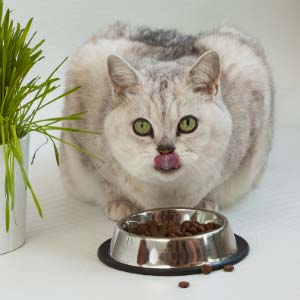 Free feeding isn't just a big contributor to the pet overweight and obesity epidemic, it also prevents you from picking up on early signs of pain and other problems, deprives your pets of an opportunity for mental stimulation and enrichment, and can make potty training much more difficult.
Free feeding isn't just a big contributor to the pet overweight and obesity epidemic, it also prevents you from picking up on early signs of pain and other problems, deprives your pets of an opportunity for mental stimulation and enrichment, and can make potty training much more difficult.
Read our "Think Twice Before Letting Your Dog or Cat Free Feed" article for more on this topic.
Also, leaving food to sit out is not ideal. The food can get stale, making your pet not want to eat it. Or if it gets wet it can mold, which can then make your cat sick if they eat it.
How to Manage Your Cat's Calorie Reduction
Dealing With a “Hangry” Cat
There are prescription diets your veterinarian may recommend to help your pet feel more full on less food, so they don’t feel as hungry and beg. Remember, never suddenly change your cat’s diet.
Rather, do it gradually over a 1–2-week period, sometimes up to 3 weeks, switching from the old diet to the new diet. Read more about how to switch your cat's food here.
How Quickly Should I Cut Back My Cat's Food?
Most people are not able to survive a diet when they have to suddenly and drastically cut back. Your cat can’t either! Gradually cut back small amounts of food per feeding until the ideal portion size is reached.
For example, reduce the amount of food by ¼ tsp per meal. Slow and steady!
What Rate of Weight Loss is Ideal for Cats?
Your cat can safely lose 0.5–2% of their body weight per week.
If you have a 20-pound cat, they can lose 0.2–0.4 pounds (or about 4 ounces) per week. It’s okay to lose less than that per week, but your weight loss plan will just take longer.
Depending on how much weight loss is needed, you can expect your cat to reach their ideal body weight in 6–8 months. If they are not progressing as they should, changes are needed.
Your veterinarian can help you determine the amount of weight per month they can and should lose.
Remember — we are all in this together! Your veterinarian is a valuable resource who can answer questions and guide you through this process of your cat's weight loss and control. Patience and consistency are the keys to success.



